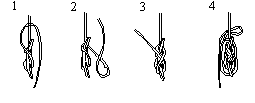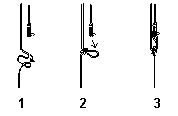Introductory Handbook
for Sailing Boats
KNOTS FOR RIGGING LIDOS
Bowline
 This is the most useful knot for sailors, since it forms a loop that will not slip or jam, and can be untied easily even after being used for heavy loads.
This is the most useful knot for sailors, since it forms a loop that will not slip or jam, and can be untied easily even after being used for heavy loads.
The diagram at right explains one way to memorize how to make a bowline. The "rabbit" is the end of the line, which you pass through the fitting you want to attach.
The "hole" is a loop formed in the main part of the line (not the end). Note how the loop spirals toward you, so that the "log" is in front of the "tree". If the "log" is behind the "tree", the knot will fall apart.
The phrase to memorize: "The rabbit pops up out of the hole, jumps over the log, runs behind the tree, and pops back down the hole".
Note that the "rabbit" ends up in the middle of the loop formed around the fitting. If you don't end up with the end in the middle of that loop, you don't have a true bowline, but instead a knot that will jam.
To untie a bowline, you loosen it as shown at right by bending the main part of the line over and pushing on the loop formed around the main part of the line. In the terms used to memorize the bowline, you find the "key" the rabbit left behind the tree.
Triple Half Hitch in a Bight

This is the best way to tie Cal Sailing Club boats to the dock. It's just three knots made with a loop of the bow painter around the rail (2 by 4) on the dock.
Be sure to tie the boat up close to the dock -- about a foot between the boat and the dock -- so that no one falls in trying to jump aboard.
Cleat Hitch
 This is the best way to tie a line around a cleat to secure the halyards. First loop the line around the cleat, then diagonally over it.
This is the best way to tie a line around a cleat to secure the halyards. First loop the line around the cleat, then diagonally over it.
Next form a loop in the end of the line, and slip the loop over the cleat, twisting the loop so that the end of the line is trapped under a diagonal across the cleat.
You should end up with the line crossing the cleat twice in one diagonal direction underneath another diagonal crossing in the other direction.
It's a good idea to wrap the halyard around the ears of the cleat as shown, so the jib sheets won't catch on the cleat.
Figure Eight Knot
 This knot is used as a stopper in the end of each jib sheet. Make a loop, then take the end around the main part of the line before bringing it through the loop.
This knot is used as a stopper in the end of each jib sheet. Make a loop, then take the end around the main part of the line before bringing it through the loop.
Stopper knots are most easily untied by bending over the main part of the line, then pushing the loop to loosen the knot.
Reef Knot

This is the trusty square knot of Scouting fame. In a reef knot, you cross the lines one way for the first knot, then the other way for the second knot.
In an ordinary double knot (also called a granny knot) you cross them the same way both times.
The reef knot is more reliable and can be untied easily even after carrying a heavy load. Just pull one end against the main part of the line nearest it.
Slip Knot for Attaching Halyards
 To secure the halyards when the sails are off, tie slip knots in them. Use the loop to attach the shackle on the halyard, and tighten the halyard and cleat it.
To secure the halyards when the sails are off, tie slip knots in them. Use the loop to attach the shackle on the halyard, and tighten the halyard and cleat it.





